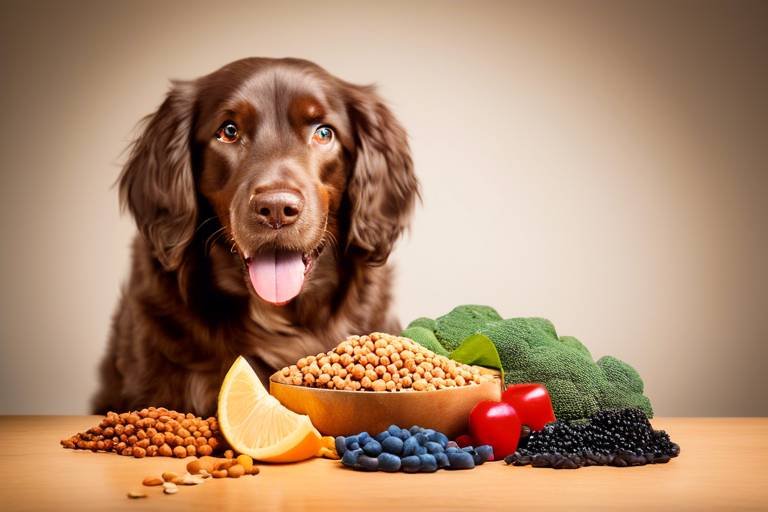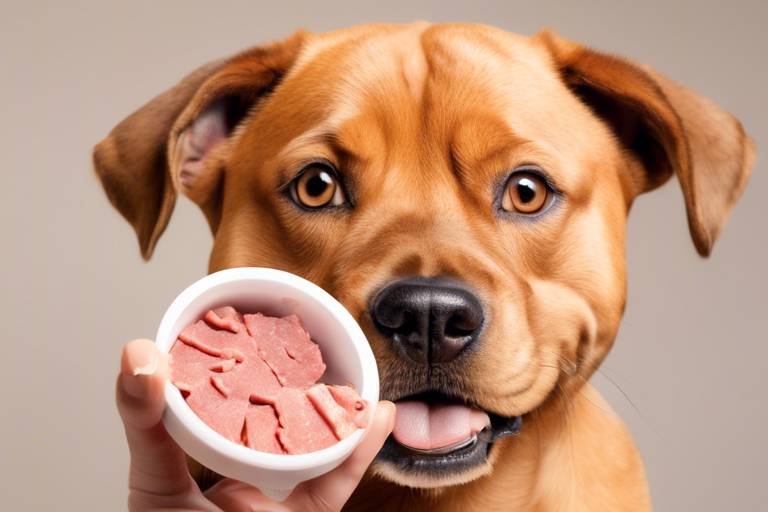Tips for Managing a Pet’s Food Sensitivities
As a loving pet owner, nothing is more heartbreaking than seeing your furry friend struggle with food sensitivities. Just like us, pets can have adverse reactions to certain foods, which can lead to discomfort and health issues. But don’t worry! With the right knowledge and strategies, you can help your pet thrive. This article provides practical advice for pet owners dealing with food sensitivities in their pets, including identifying symptoms, choosing the right diet, and implementing management strategies for a healthier, happier pet.
Food sensitivities in pets can lead to various health issues. It’s essential to understand that food allergies and sensitivities are not the same. Food allergies involve the immune system and can cause severe reactions, while food sensitivities typically result in milder digestive issues. Recognizing the difference is crucial for proper care and dietary adjustments. If your pet is frequently uncomfortable or has unexplained symptoms, it might be time to investigate their diet.
Recognizing the symptoms of food sensitivities is crucial for timely intervention. Many pet owners overlook subtle signs, thinking they are just part of their pet’s behavior. However, being vigilant can lead to early detection and better management. Common signs to watch for include:
- Gastrointestinal disturbances such as vomiting and diarrhea.
- Skin irritations like itching and redness.
- Behavioral changes such as increased irritability or lethargy.
By being attentive to these symptoms, you can take proactive steps to ensure your pet’s comfort and health.
Gastrointestinal issues such as vomiting, diarrhea, and bloating are common indicators of food sensitivities. If you notice your pet having frequent tummy troubles, it’s a red flag. Understanding these symptoms can help you take appropriate action. For instance, if your pet is experiencing persistent diarrhea, it might be time to consult with your veterinarian to rule out any serious conditions and explore potential dietary changes.
Skin reactions like itching, redness, and rashes often signal food sensitivities. It’s easy to confuse these symptoms with allergies, but they can stem from dietary issues as well. If your pet is scratching excessively or has developed rashes, it’s crucial to address these skin issues promptly. Ignoring them can lead to infections or more severe complications. A veterinarian can help differentiate between allergies and sensitivities, guiding you toward the right treatment.
Behavioral changes, including increased irritability or lethargy, can also be signs of food sensitivities. Just like how we can feel off when we eat something that doesn’t agree with us, our pets can react similarly. If you notice your pet acting unusually, it’s essential to observe them closely and consider whether a dietary change might be beneficial. Sometimes, a simple switch in their food can bring back their playful spirit.
Consulting a veterinarian is essential for diagnosing food sensitivities accurately. They can provide invaluable guidance in developing a tailored dietary plan that fits your pet’s specific needs. It’s not just about switching foods; it’s about ensuring your pet’s overall health and well-being. A professional can help you navigate the complex world of pet nutrition and ensure that your furry friend receives the best care possible.
Selecting the right diet is crucial for managing food sensitivities. It can feel overwhelming with so many options available, but focusing on a few key factors can simplify the process. Hypoallergenic diets, for instance, can significantly alleviate symptoms associated with food sensitivities. When looking for hypoallergenic products, check for limited ingredient lists and avoid common allergens.
Hypoallergenic pet food options can help alleviate symptoms associated with food sensitivities. Look for products that are specifically labeled as hypoallergenic. These foods are often made with novel proteins and carbohydrates that your pet may not have been exposed to before, reducing the chance of a reaction. The right hypoallergenic diet can make a world of difference in your pet’s comfort and overall health.
Understanding ingredient sourcing is vital for selecting appropriate pet food. Always read labels carefully and identify potential allergens. High-quality ingredients are essential for your pet’s health, so look for brands that prioritize transparency in their sourcing. Knowing where your pet’s food comes from can give you peace of mind and ensure that you’re making the best choices for their dietary needs.
Q: How can I tell if my pet has a food sensitivity?
A: Look for symptoms such as gastrointestinal issues, skin irritations, or behavioral changes. If you notice any of these signs, consult your veterinarian for guidance.
Q: Can I change my pet's diet on my own?
A: While you can make dietary changes, it’s best to consult with a veterinarian to ensure the new diet meets your pet’s nutritional needs and to rule out any underlying health issues.
Q: What are some common allergens in pet food?
A: Common allergens include beef, chicken, dairy, wheat, and soy. Hypoallergenic diets often use novel proteins like duck or fish to reduce the risk of reactions.
Q: How long does it take to see improvements after changing my pet's diet?
A: It can take several weeks to notice significant improvements. Be patient and monitor your pet closely during this transition.

Understanding Food Sensitivities
Food sensitivities in pets can be a perplexing challenge for many pet owners. Often confused with food allergies, food sensitivities are less severe but can still lead to a myriad of health issues if left unaddressed. It's crucial to understand the distinction between the two: while food allergies typically provoke an immediate immune response, food sensitivities often result in delayed reactions that can manifest over time. Recognizing these differences is the first step toward ensuring your furry friend receives the proper care they deserve.
Symptoms of food sensitivities can range from mild to severe and may affect your pet’s overall quality of life. Imagine your pet feeling uncomfortable or in pain, but you can’t pinpoint the cause. This uncertainty can be frustrating for both you and your pet. Therefore, being aware of the signs and symptoms is essential. For instance, gastrointestinal disturbances, such as vomiting or diarrhea, may occur, but they can also be indicative of other health issues. Thus, keeping a keen eye on your pet’s behavior and physical state is paramount.
Additionally, skin irritations like itching or rashes are common indicators of food sensitivities. You might notice your pet scratching more than usual or developing red patches on their skin. Such reactions can lead to further complications if not addressed promptly. It’s vital to differentiate between food allergies and sensitivities, as the management strategies may vary significantly. In many cases, consulting a veterinarian can provide clarity and guidance on the best course of action.
Lastly, behavioral changes can also be a significant clue. If your usually playful pup suddenly becomes lethargic or irritable, it may be time to investigate potential dietary issues. Pets communicate their discomfort in various ways, and as their loving owners, it’s our responsibility to listen and respond. By understanding food sensitivities, we can take proactive steps toward managing our pets’ diets, leading to happier, healthier lives.

Identifying Symptoms
Recognizing the symptoms of food sensitivities in your beloved pet is crucial for timely intervention and effective management. Just like humans, pets can experience discomfort and health issues when they consume something that doesn’t agree with them. The signs can be subtle at first, but if you know what to look for, you can make a world of difference in your furry friend's quality of life. So, what should you keep an eye out for? Let’s dive into some common symptoms that might indicate your pet is struggling with food sensitivities.
First and foremost, one of the most noticeable signs of food sensitivities is gastrointestinal disturbances. If your pet is experiencing issues such as vomiting, diarrhea, or even bloating, it could be a strong indicator that their diet needs a closer examination. These symptoms can lead to dehydration and lethargy, which can be alarming for any pet owner. If you notice these signs, it’s essential to consult with your veterinarian to discuss possible dietary changes.
Gastrointestinal issues are often the first red flags when it comes to food sensitivities. Imagine your pet’s stomach as a delicate balance; when the wrong food enters the mix, it can throw everything off. For instance, if your dog suddenly starts having accidents in the house or your cat refuses to eat, it’s time to pay attention. These symptoms can manifest in various ways, including:
- Vomiting: Frequent vomiting can indicate that your pet's stomach is not tolerating certain foods.
- Diarrhea: Loose stools or diarrhea can lead to serious dehydration.
- Bloating: A distended stomach can be uncomfortable and even painful for your pet.
Understanding these symptoms can help you take the appropriate action and consult with veterinarians for effective management strategies.
Another common issue that many pet owners overlook is skin reactions. If your pet is constantly scratching, biting, or licking at their skin, it might not just be a case of fleas or dry skin. Instead, these skin irritations can often signal food sensitivities. Watch for signs such as itching, redness, or rashes. These symptoms can be uncomfortable and may lead to more severe skin infections if not addressed promptly. It’s essential to differentiate between food allergies and sensitivities, as they require different approaches. If your pet is experiencing skin issues, don’t wait too long to consult your veterinarian.
Lastly, keep an eye on your pet’s behavior. Just as we might feel cranky or sluggish after eating something that doesn't sit well, pets can exhibit similar behavioral changes. Increased irritability or lethargy can be signs of discomfort linked to food sensitivities. If your usually playful pup suddenly becomes withdrawn or your cat seems less interested in their favorite activities, it could be time to reevaluate their diet. Observing these behavioral changes closely can provide valuable insights into your pet's overall well-being.
When it comes to diagnosing food sensitivities accurately, consulting a veterinarian is essential. They have the expertise to help decipher your pet's symptoms and recommend a tailored dietary plan that suits their specific needs. Remember, your pet relies on you to make the right choices for their health, so don’t hesitate to seek professional guidance!
Q: How can I tell if my pet has a food sensitivity?
A: Look for symptoms such as gastrointestinal disturbances, skin irritations, or behavioral changes. If you notice any of these signs, consult your veterinarian for advice.
Q: Can I switch my pet's diet on my own?
A: While you can research and choose new foods, it's best to consult with your veterinarian to ensure the new diet meets your pet's specific needs.
Q: What are hypoallergenic diets?
A: Hypoallergenic diets are specially formulated to reduce the risk of allergic reactions. They often contain novel proteins and limited ingredients to help manage food sensitivities.
Gastrointestinal Issues
When it comes to our furry friends, gastrointestinal issues can be a major red flag indicating food sensitivities. Imagine your pet as a delicate machine; when the right fuel isn’t provided, it can lead to a breakdown. Common symptoms like vomiting, diarrhea, and bloating are often the first signs that something is amiss in their diet. These symptoms can range from mild to severe, and recognizing them early can make a world of difference in your pet's health.
For instance, if your dog suddenly starts having loose stools or if your cat is frequently vomiting after meals, it’s time to take a closer look at what they’re eating. These gastrointestinal disturbances can be more than just an upset stomach; they can lead to dehydration and other serious health issues if left unchecked. So, how do you know when it’s time to consult a veterinarian? Here are some key indicators:
- If your pet experiences persistent vomiting or diarrhea for more than 24 hours.
- If there is blood in their stool or vomit.
- If your pet shows signs of lethargy or discomfort.
Understanding the underlying causes of these gastrointestinal issues is vital. Food sensitivities can often be mistaken for food allergies, but they are distinct conditions. While allergies trigger an immune response, sensitivities typically lead to digestive upset without that immune flare-up. This means that even if your pet isn’t showing classic allergic reactions, they could still be suffering from discomfort due to their diet.
In many cases, a simple dietary change can alleviate these symptoms. For example, switching to a limited-ingredient diet can help pinpoint the specific ingredient causing the problem. This approach allows you to introduce new foods gradually, monitoring for any adverse reactions. It’s like being a detective for your pet’s health—every meal is a clue that can lead you to the culprit behind their discomfort.
Additionally, keeping a food diary can be incredibly helpful. Write down everything your pet eats, along with any symptoms they exhibit. Over time, patterns may emerge that can guide both you and your veterinarian in making informed decisions about their diet. This proactive approach not only helps in managing their current issues but can also prevent future gastrointestinal problems from arising.
In conclusion, being vigilant about your pet’s gastrointestinal health is crucial. By recognizing the signs of food sensitivities and taking appropriate action, you can help ensure that your beloved companion stays happy and healthy. Remember, a happy pet is a healthy pet, and it all starts with the right diet!
Q: What should I do if my pet has frequent gastrointestinal issues?
A: If your pet frequently experiences gastrointestinal issues, it’s essential to consult your veterinarian. They can help identify the underlying cause and suggest appropriate dietary changes.
Q: How can I tell if my pet has a food sensitivity or allergy?
A: Food sensitivities typically cause digestive upset, while allergies may lead to skin reactions or respiratory issues. Observing your pet's symptoms and consulting a veterinarian can help clarify the distinction.
Q: Are there specific ingredients I should avoid in my pet's diet?
A: Common allergens include beef, chicken, dairy, wheat, and soy. However, every pet is unique, so it’s essential to consult with your veterinarian for tailored advice.
Skin Reactions
When it comes to our furry friends, skin reactions can be a significant indicator of underlying food sensitivities. Just like humans, pets can experience a range of skin issues that are often tied to what they eat. If you've noticed your pet scratching more than usual or developing red patches on their skin, it could be time to take a closer look at their diet. These reactions can manifest in various ways, including itchiness, redness, rashes, and even hair loss. Addressing these symptoms promptly is crucial, as they can lead to more severe health complications if ignored.
One of the first steps in determining whether your pet's skin reactions are due to food sensitivities is to differentiate between food allergies and food intolerances. While both can cause distress, food allergies typically involve the immune system and can lead to more severe reactions, whereas food sensitivities may cause discomfort without the same level of immune response. Understanding this distinction can help you and your veterinarian tailor a more effective management plan.
For example, if your pet is experiencing skin irritations alongside gastrointestinal issues, it might indicate a more systemic reaction to their food. In such cases, keeping a detailed record of your pet's diet and any symptoms can be incredibly helpful. Consider maintaining a food diary that includes:
- What your pet eats daily
- Any treats or table scraps given
- Notable changes in behavior or skin condition
This information can be invaluable when discussing your pet's health with a veterinarian. They may recommend specific tests or suggest an elimination diet to pinpoint the exact cause of the skin reactions. An elimination diet involves removing potential allergens from your pet's food for a period and then gradually reintroducing them to observe any reactions. This process can help clarify whether your pet's discomfort is indeed linked to their diet.
It's essential to remember that while skin reactions can be alarming, they are often manageable with the right approach. Switching to a hypoallergenic diet can provide relief for many pets suffering from food sensitivities. These diets typically contain limited ingredients and avoid common allergens, making them a safer choice for sensitive pets. Additionally, discussing with your veterinarian about appropriate supplements, like omega fatty acids, can also help improve skin health and reduce inflammation.
In conclusion, keeping an eye on your pet's skin health is just as important as monitoring their overall well-being. By being proactive and observant, you can help your furry companion live a happier, healthier life, free from the discomfort of food sensitivities.
Q: How do I know if my pet has food sensitivities?
A: Look for signs such as gastrointestinal issues, skin irritations, and behavioral changes. Keeping a food diary can help track symptoms related to their diet.
Q: Can I treat my pet's skin reactions at home?
A: While some mild skin irritations can be managed with over-the-counter treatments, it's best to consult with a veterinarian for proper diagnosis and treatment options.
Q: What ingredients should I avoid in my pet's food?
A: Common allergens include grains, dairy, beef, chicken, and certain artificial additives. Always read labels carefully and consult with your vet for specific recommendations.
Q: How long does it take to see improvement after changing my pet's diet?
A: It can take several weeks to notice significant changes after switching to a new diet, especially if an elimination diet is being followed. Patience is key!
Behavioral Changes
When it comes to our furry friends, behavioral changes can often be the most telling signs of discomfort, especially when food sensitivities are at play. Imagine your pet as a little detective, trying to communicate their feelings through actions rather than words. If your usually playful pup suddenly becomes lethargic or irritable, it’s time to pay attention. These changes in behavior can stem from the discomfort caused by food sensitivities, leading to a variety of emotional and physical responses.
For instance, you might notice that your cat, who once loved to chase after toys, now prefers to curl up in a corner, seemingly uninterested in playtime. This shift can be alarming and may indicate that something is off with their diet. Similarly, dogs may exhibit signs of irritability, such as growling or snapping, when they are uncomfortable. It’s essential to recognize that these behavioral changes are not just quirks; they are your pet's way of expressing distress.
To better understand the potential behavioral changes associated with food sensitivities, consider the following:
- Lethargy: A significant decrease in energy levels can signal discomfort.
- Irritability: An increase in aggression or irritability may indicate that your pet is in pain.
- Withdrawal: Pets may isolate themselves when they are not feeling well, showing less interest in social interactions.
- Increased vocalization: Some pets may become more vocal, whining or barking more than usual, to express their discomfort.
It’s crucial to observe your pet’s behavior closely. If you notice any of these signs, consider keeping a journal of their eating habits and any changes in their behavior. This record can be invaluable when consulting your veterinarian, as it provides concrete evidence of what your pet is experiencing. Remember, just like us, pets can have off days, but persistent changes should never be ignored.
In addition to monitoring behavior, it’s important to think about the potential triggers of these changes. Sometimes, it’s not just about the food itself but also how your pet reacts to different environments or stressors. For example, a change in routine, a new pet in the house, or even a recent visit to the vet can all contribute to behavioral shifts. By addressing these factors, alongside dietary changes, you can help your pet regain their happy, playful demeanor.
In conclusion, keeping an eye on your pet’s behavior is just as important as monitoring their physical health. If you suspect food sensitivities are affecting your pet, don’t hesitate to consult with a veterinarian. Together, you can explore dietary options and management strategies that will lead to a healthier, happier life for your beloved companion.
- What are the most common symptoms of food sensitivities in pets? Common symptoms include gastrointestinal issues, skin irritations, and noticeable behavioral changes.
- How can I determine if my pet has a food sensitivity? Keeping a food diary and noting any changes in behavior or health after eating specific foods can help. Consulting a veterinarian for tests may also be necessary.
- Are hypoallergenic diets effective for all pets with food sensitivities? While hypoallergenic diets can help many pets, it's essential to work with your vet to find the best option for your specific pet.
- How long does it take to see improvements after changing my pet's diet? Improvements can vary, but many pet owners notice changes within a few weeks of switching to a suitable diet.
Consulting a Veterinarian
When it comes to managing your pet's food sensitivities, is not just a suggestion—it's a necessity. Think of your vet as the ultimate detective in your pet's health journey. They have the expertise and tools to uncover the underlying issues that may be causing your furry friend discomfort. Whether your pet is experiencing gastrointestinal problems, skin irritations, or behavioral changes, a vet can provide a thorough examination and help you piece together the puzzle of your pet's health.
During your visit, the veterinarian will likely ask a series of questions to gather information about your pet's symptoms and dietary habits. This is where you can play the role of the informant. Be prepared to discuss:
- Your pet's eating habits and preferences
- Any recent changes in diet or lifestyle
- Specific symptoms you've noticed, including when they occur
- Any previous health issues or allergies
Once the vet has a clear picture, they may recommend diagnostic tests, such as blood work or allergy testing, to pinpoint the exact cause of your pet's discomfort. This step is crucial because it allows for a tailored approach to treatment. After identifying the specific food sensitivities, your veterinarian can help you develop a customized dietary plan that caters to your pet's unique needs.
Additionally, it's essential to keep communication open with your veterinarian after the initial consultation. As you implement dietary changes, keep an eye on your pet's response. If symptoms persist or worsen, don't hesitate to reach out for further guidance. Your vet can make necessary adjustments to the dietary plan and suggest alternative solutions, ensuring your pet's journey to better health is smooth and effective.
Ultimately, consulting a veterinarian is about more than just addressing immediate symptoms; it's about establishing a long-term health strategy for your pet. With their expertise, you can transform your pet's diet into a source of energy and vitality rather than discomfort and distress. So, if you suspect your pet has food sensitivities, don’t wait—schedule that vet appointment today!
Here are some common questions pet owners have regarding food sensitivities:
- What are the common symptoms of food sensitivities in pets? Symptoms can include gastrointestinal issues like vomiting and diarrhea, skin irritations, and behavioral changes.
- How can I determine if my pet has a food sensitivity? A vet can help diagnose food sensitivities through examinations and tests, but observing your pet's reactions to certain foods is also crucial.
- Are hypoallergenic diets effective for all pets? While many pets benefit from hypoallergenic diets, it's important to consult with a veterinarian to find the best option for your specific pet.
- How long does it take to see improvements after changing my pet’s diet? Improvements can vary, but many pet owners notice changes within a few weeks of switching to a suitable diet.

Choosing the Right Diet
When it comes to managing your pet's food sensitivities, is absolutely crucial. Just like humans, pets can experience a wide range of reactions to certain foods, and finding the right balance can be a game-changer for their health and happiness. Imagine trying to find a needle in a haystack; that’s what it can feel like sifting through pet food options. However, with a little knowledge and patience, you can uncover the perfect diet that meets your pet’s unique needs.
First off, let’s talk about hypoallergenic diets. These specially formulated foods are designed to minimize the risk of allergic reactions and often contain novel proteins—like duck or venison—that your pet hasn’t encountered before. Think of it as introducing your pet to a whole new culinary world, one where they can enjoy meals without the pesky side effects of food sensitivities. When selecting a hypoallergenic diet, look for products that list a single source of protein and limited ingredients. This can help you pinpoint what works best for your furry friend.
In addition to hypoallergenic options, understanding ingredient sourcing is vital. Reading labels is like decoding a secret language; it can be overwhelming, but it’s essential for making informed choices. Here are a few tips to help you navigate pet food labels:
- Check for Quality Ingredients: Look for whole food ingredients that are recognizable. If you can’t pronounce it, maybe it’s best to avoid it.
- Avoid Fillers: Ingredients like corn and wheat can often trigger sensitivities. Aim for diets rich in protein and healthy fats.
- Watch for Additives: Artificial colors, flavors, and preservatives can exacerbate food sensitivities. Stick to natural options whenever possible.
Transitioning your pet to a new diet is another critical step. You wouldn’t jump into a cold pool without easing in first, right? The same principle applies to changing your pet’s food. Gradually introduce the new diet over a week or so by mixing it with their current food. Start with a 25% new food and 75% old food, and gradually increase the new food while decreasing the old food. This slow transition can help prevent gastrointestinal upset.
It’s also worth noting that some pets may have specific dietary needs based on their age, breed, or health status. For instance, a senior dog might require a diet lower in calories but higher in fiber, while an active puppy may need a diet rich in protein to support their growth. Always consider these factors when selecting a diet, as a one-size-fits-all approach rarely works in the world of pet nutrition.
Lastly, don’t hesitate to involve your veterinarian in the conversation. They can provide tailored advice and recommend specific brands or formulations that align with your pet’s sensitivities. Just like a trusted guide on a hiking trail, a vet can help you navigate the complex landscape of pet nutrition.
Q: How can I tell if my pet has food sensitivities?
A: Look for signs such as gastrointestinal issues, skin irritations, or behavioral changes. If you notice any of these symptoms, it’s best to consult your veterinarian.
Q: What should I look for in hypoallergenic pet food?
A: Choose foods with limited ingredients, a single protein source, and no artificial additives. This helps reduce the risk of triggering sensitivities.
Q: How long does it take for a new diet to show results?
A: It can take several weeks for you to see noticeable improvements in your pet’s health after switching diets. Consistency is key!
Q: Can I make homemade food for my pet with sensitivities?
A: Yes, but it’s crucial to consult with your veterinarian to ensure that the homemade diet meets all of your pet’s nutritional needs.
Hypoallergenic Options
When it comes to managing your pet's food sensitivities, selecting the right diet can feel like navigating a maze. One of the most effective solutions is to consider hypoallergenic pet food options. These specially formulated diets are designed to minimize the risk of allergic reactions and provide relief from discomfort. But what exactly should you look for in hypoallergenic products? Let's delve into the essentials.
First and foremost, hypoallergenic pet foods typically contain limited ingredients. This means they avoid common allergens like beef, chicken, dairy, and wheat, which can trigger sensitivities in many pets. Instead, they often feature novel protein sources such as duck, venison, or fish. By introducing these less common proteins, you can help your furry friend enjoy their meals without the worry of adverse reactions.
Moreover, it’s crucial to pay attention to the carbohydrate sources in hypoallergenic diets. Many brands utilize potatoes or peas instead of grains, making the food easier to digest and less likely to cause gastrointestinal upset. As you explore different options, consider checking the ingredient list for high-quality, recognizable components. The goal is to find a product that nourishes your pet while steering clear of potential irritants.
Another aspect to consider is the manufacturing process. Look for brands that prioritize quality control and transparency. A reputable manufacturer will often provide detailed information about their sourcing practices and the standards they adhere to. This can help you feel more confident about the food you are providing to your beloved pet. Additionally, some hypoallergenic diets are available in both dry and wet forms, giving you the flexibility to cater to your pet's preferences.
Transitioning your pet to a hypoallergenic diet should be done gradually. A sudden change can upset their stomach, leading to further discomfort. Start by mixing a small amount of the new food with their current diet, gradually increasing the proportion of the hypoallergenic food over a week or two. This slow transition can help minimize any digestive issues and allow your pet to adjust to the new flavors and textures.
In summary, hypoallergenic options can be a game changer for pets with food sensitivities. By choosing limited ingredient diets, opting for novel protein sources, and ensuring high-quality manufacturing, you can set your pet on the path to better health and comfort. Remember, every pet is unique, so it may take some trial and error to find the perfect fit. But with patience and careful observation, you’ll be well on your way to providing your furry friend with the relief they deserve.
- What are the signs my pet has food sensitivities? Look for symptoms like vomiting, diarrhea, itching, or changes in behavior.
- How long does it take to see improvement after switching diets? It can take a few weeks to notice significant changes, so patience is key.
- Can I make homemade hypoallergenic food? Yes, but it’s essential to consult with your veterinarian to ensure it meets your pet's nutritional needs.
- Are all hypoallergenic foods the same? No, they can vary significantly in ingredients and quality, so always read labels carefully.
Ingredient Sourcing
When it comes to managing your pet's food sensitivities, is paramount. Think of it as being a detective in your pet's nutritional journey; you need to scrutinize every label and ingredient list to ensure you’re not inadvertently feeding them something that could trigger an adverse reaction. The first step in this process is to become familiar with the common allergens that could be lurking in your pet's food. Ingredients like wheat, corn, soy, and certain proteins can often be culprits in food sensitivities. Therefore, it's crucial to read labels meticulously and understand what each ingredient means.
One effective way to navigate ingredient sourcing is to look for high-quality, single-source protein. This means that the food should primarily contain one type of meat, such as chicken, lamb, or fish, which can help reduce the risk of allergic reactions. Additionally, selecting foods with limited ingredients can simplify the process, allowing you to pinpoint any potential allergens more easily. Always check for the presence of fillers or artificial additives, as these can sometimes aggravate your pet's sensitivities.
Here’s a simple table to help you understand the types of ingredients to look for and those to avoid:
| Type | Examples | Notes |
|---|---|---|
| High-Quality Proteins | Chicken, Turkey, Lamb, Fish | Opt for specific sources to limit exposure to allergens. |
| Carbohydrates | Sweet Potatoes, Brown Rice | These are generally well-tolerated by pets with sensitivities. |
| Avoid | Wheat, Corn, Soy | Common allergens that can trigger food sensitivities. |
| Fillers & Additives | Artificial Colors, Preservatives | These can cause digestive issues and should be avoided. |
Moreover, it's essential to consider the sourcing of the ingredients. Many pet food brands now emphasize transparency regarding where their ingredients come from. Look for companies that provide detailed information about their suppliers and the quality of the ingredients they use. Brands that source ingredients from reputable farms and fisheries are often more reliable. This not only ensures better quality but also gives you peace of mind knowing that your pet is consuming safe and nutritious food.
Finally, transitioning your pet to a new diet should be done gradually. Abrupt changes can lead to gastrointestinal upset, which is counterproductive when you’re trying to manage food sensitivities. Mix the new food with the old food over a week or so, slowly increasing the proportion of the new diet. This gradual approach allows your pet's digestive system to adapt and can help you monitor for any adverse reactions to the new ingredients.
- What are the signs my pet might have food sensitivities? Look for gastrointestinal issues, skin irritations, and behavioral changes.
- How can I determine if my pet has a food sensitivity? Consult with a veterinarian for proper testing and dietary recommendations.
- Is a hypoallergenic diet suitable for all pets? Not necessarily; it's essential to tailor the diet to your pet's specific needs.
- Can I make homemade food for my pet with sensitivities? Yes, but it's crucial to consult with a vet to ensure balanced nutrition.
Frequently Asked Questions
- What are the common symptoms of food sensitivities in pets?
Common symptoms of food sensitivities include gastrointestinal issues like vomiting and diarrhea, skin reactions such as itching and rashes, and behavioral changes like irritability or lethargy. If you notice any of these signs, it's essential to observe your pet closely and consider dietary adjustments.
- How can I differentiate between food allergies and food sensitivities?
Food allergies typically involve an immune response that can lead to severe reactions, while food sensitivities often result in discomfort without the immune system's involvement. Symptoms of allergies can include hives and severe gastrointestinal upset, whereas sensitivities usually manifest as milder gastrointestinal disturbances and skin irritations.
- Should I consult a veterinarian if I suspect my pet has food sensitivities?
Absolutely! Consulting a veterinarian is crucial for accurate diagnosis and to develop a tailored dietary plan. A vet can help identify specific allergens and recommend appropriate hypoallergenic diets to ensure your pet's health and comfort.
- What are hypoallergenic diets, and how can they help my pet?
Hypoallergenic diets are specially formulated to minimize the risk of allergic reactions in pets. They often contain limited ingredients and are designed to avoid common allergens. Switching to a hypoallergenic diet can help alleviate symptoms associated with food sensitivities, promoting better health and well-being for your furry friend.
- How do I transition my pet to a new diet safely?
To transition your pet to a new diet, do it gradually over a week or so. Start by mixing a small portion of the new food with the current food, gradually increasing the new food while decreasing the old. This slow transition helps prevent gastrointestinal upset and allows your pet to adjust to the new diet.
- What should I look for on pet food labels to avoid allergens?
When reading pet food labels, look for specific ingredients that your pet may be sensitive to. Avoid foods that list common allergens like wheat, corn, soy, and certain animal proteins. Instead, opt for high-quality ingredients and consider foods that specify being free from common allergens.



















